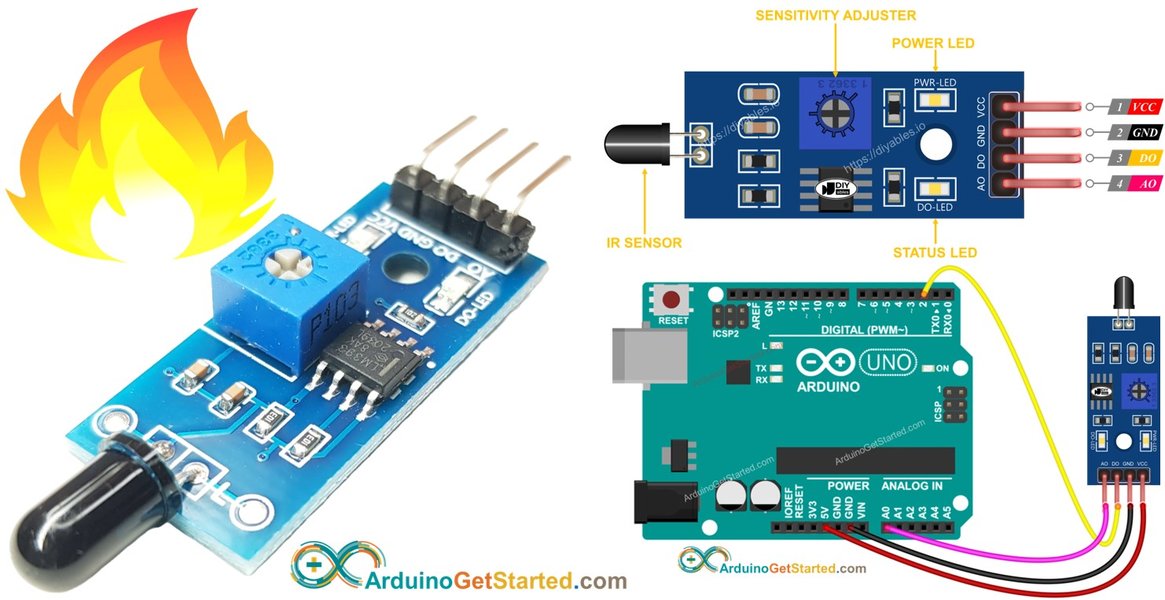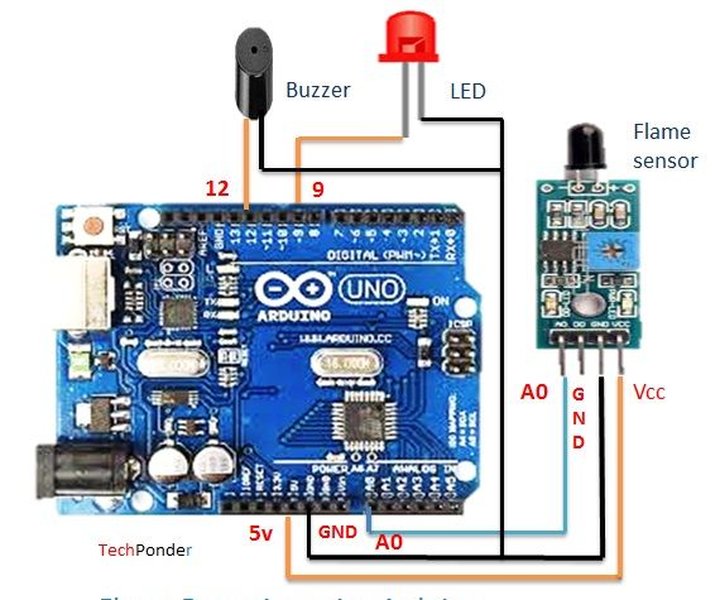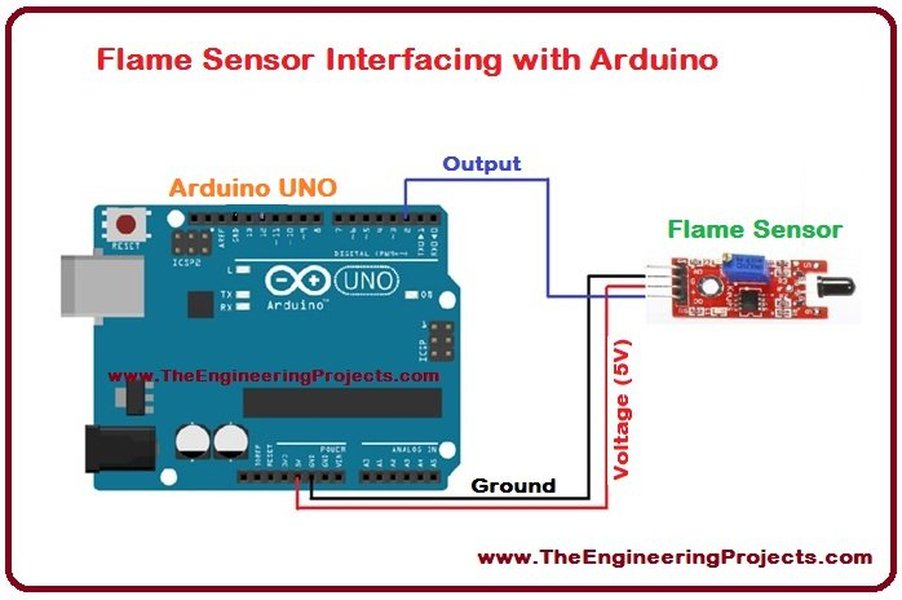
Unleash the Power of Fire Detection: A Deep Dive into Flame Sensors
Explore practical examples and applications of flame sensors, essential components in modern safety systems.
Key Highlights of Flame Sensor Applications
- Early Fire Detection: Flame sensors detect fires quickly by sensing infrared or ultraviolet radiation, enabling rapid response.
- Versatile Applications: Used in industrial boilers, fire-fighting robots, and home safety systems for comprehensive fire detection.
- Integration with Microcontrollers: Flame sensors easily interface with Arduino and other microcontrollers for customized fire safety solutions.
Understanding Flame Sensors
A flame sensor is a detector that responds to the presence of a flame. Flame sensors are designed to detect the presence of a flame by monitoring infrared (IR) or ultraviolet (UV) radiation emitted during combustion. These sensors are crucial components in fire detection systems, offering a rapid response compared to traditional smoke or heat detectors.
How Flame Sensors Work
Flame sensors operate on the principle of detecting specific types of radiation emitted by flames. Here’s a detailed breakdown:
- IR Flame Sensors: These sensors detect infrared radiation emitted by hot gases. They often require a flickering motion of the flame to avoid false alarms from other IR sources like ovens or lamps.
- UV Flame Sensors: These sensors detect ultraviolet radiation produced at the point of ignition. They are highly sensitive to flames but can also be triggered by other UV sources.
- UV/IR Flame Sensors: Combining both UV and IR sensors, these detectors offer enhanced accuracy and reduced false alarms. They process signals from both sensors to confirm the presence of a flame.
Components of a Flame Sensor Module
A typical flame sensor module includes several key components:
- IR Photodiode/Phototransistor: Detects infrared radiation. Examples include the YG1006 phototransistor, which is sensitive to light in the 760 nm to 1100 nm wavelength range (Flame Sensor : Working, Types, Interfacing & Its Applications - watelectronics.com).
- LM393 Comparator IC: Compares the voltage received from the IR receiver to a threshold, triggering an output signal when a flame is detected (Arduino Flame Sensor Tutorial - How Flame Sensor Works and ... - circuitdigest.com).
- Variable Resistor (Trim Pot): Allows adjustment of the sensor's sensitivity.
- LED Indicators: Indicate power status and flame detection.
Pin Configuration
Flame sensor modules typically have 3 or 4 pins:
- VCC: Power supply (3.3V-5V).
- GND: Ground.
- DO (Digital Output): Digital signal indicating the presence or absence of a flame.
- AO (Analog Output): Analog signal providing a variable voltage relative to the flame intensity (available on 4-pin versions).
Practical Examples and Applications
Arduino-Based Fire Detection System
One common application of flame sensors is in fire detection systems using Arduino. The flame sensor detects the presence of a flame, and the Arduino triggers an alarm or activates a fire suppression system.
Example Code Snippet
Here’s a basic Arduino code snippet for interfacing with a flame sensor:
// Define the LED pin
#define led 3
// Define the digital pin for the flame sensor
#define digitalPin 2
int digitalVal;
void setup() {
// Set the LED pin as an output
pinMode(led, OUTPUT);
// Set the flame sensor pin as an input
pinMode(digitalPin, INPUT);
// Enable the internal pull-up resistor
pinMode(digitalPin, INPUT_PULLUP);
}
void loop() {
// Read the digital value from the flame sensor
digitalVal = digitalRead(digitalPin);
// If a flame is detected (LOW signal)
if (digitalVal == HIGH) {
// Turn ON the LED
digitalWrite(led, HIGH);
} else {
// Turn OFF the LED
digitalWrite(led, LOW);
}
}
This code continuously monitors the digital pin connected to the flame sensor. When a flame is detected (indicated by a HIGH signal due to the INPUT_PULLUP configuration), the LED connected to pin 3 turns on. Otherwise, the LED remains off.
Interfacing with Arduino
To interface a flame sensor with an Arduino:
- Connect the VCC pin of the flame sensor to the 5V pin on the Arduino.
- Connect the GND pin of the flame sensor to the GND pin on the Arduino.
- Connect the DO pin of the flame sensor to a digital pin on the Arduino (e.g., pin 2).
- Optionally, connect the AO pin to an analog pin on the Arduino for reading analog values.
Applications in Robotics
Flame sensors are also used in fire-fighting robots to detect and extinguish fires. These robots use the sensor data to navigate towards the fire source.
Fire-Fighting Robot Example
In a fire-fighting robot, the flame sensor acts as the robot's "eyes," helping it locate the fire source. The robot can then use onboard mechanisms to extinguish the fire, such as a water pump or a fire extinguisher.
Industrial Applications
In industrial settings, flame sensors are used in boilers and furnaces to ensure proper operation. They verify that the flame is present and stable, preventing hazardous situations.
Boiler Monitoring
Flame sensors in boilers confirm that the boiler is functioning correctly. If the flame goes out unexpectedly, the sensor can trigger a safety shutdown to prevent gas leaks or explosions (Flame Sensor : Working, Types, and Its Applications - elprocus.com).
Advantages and Disadvantages
Flame sensors offer several advantages, but they also have some limitations:
Advantages
- Rapid Response Time: Flame sensors respond faster than smoke or heat detectors, providing early warning of a fire.
- Versatile Detection: They can detect flames even when smoke is not yet present.
- Remote Detection: Flame sensors can detect flames from a distance, making them suitable for large areas.
Disadvantages
-
False Alarms: Can be triggered by other sources of radiation, such as sunlight, lamps, or welding arcs.
-
Limited Field of View: The sensor must have a direct line of sight to the flame.
-
Environmental Sensitivity: Performance can be affected by dust, oil, or water vapor.
Key Differences Between Flame Sensor Types
The market offers several types of flame sensors, each with unique detection methods. Here is a comparison of the key differences:
| Sensor Type | Detection Method | Advantages | Disadvantages | Typical Applications |
|---|---|---|---|---|
| IR Flame Sensor | Detects infrared radiation emitted by hot gases. | High sensitivity to flames; Cost-effective. | Prone to false alarms from other IR sources; Requires flickering flame. | Industrial boilers, home safety systems. |
| UV Flame Sensor | Detects ultraviolet radiation produced at ignition. | Fast response time; High sensitivity to flames. | Can be triggered by non-flame UV sources; Limited range. | Gas-burning furnaces, high-risk fire areas. |
| UV/IR Flame Sensor | Combines UV and IR detection for enhanced accuracy. | Reduced false alarms; Reliable detection. | More complex and expensive. | Critical safety systems, aerospace. |
Visualizing Flame Sensor Applications
Explore diverse applications of flame sensors with these images.



These images illustrate the versatility of flame sensors in various projects and applications. From basic Arduino setups to more complex fire detection systems, flame sensors provide essential fire safety measures. The ability to interface with microcontrollers like Arduino allows for customized solutions tailored to specific needs, whether it's a home safety system or an industrial monitoring setup. The different wiring diagrams and module setups also highlight the ease of integration, making flame sensors accessible for both hobbyists and professionals alike.
Enhancing Fire Safety with Flame Sensors and Arduino
Learn how to build a fire detection system using a flame sensor and Arduino in this informative video.
This video demonstrates the practical application of flame sensors with Arduino to create a fire detection system. It covers the necessary components, connections, and code required to detect a flame and trigger an alarm. By watching this video, viewers can gain a clear understanding of how to integrate a flame sensor with Arduino and develop their own fire safety projects. The video provides step-by-step instructions, making it accessible for beginners while also offering valuable insights for experienced users looking to enhance their fire detection capabilities. Understanding these applications will lead to creating more robust fire detection and prevention systems.
Frequently Asked Questions
References
Last updated April 10, 2025